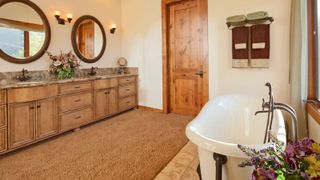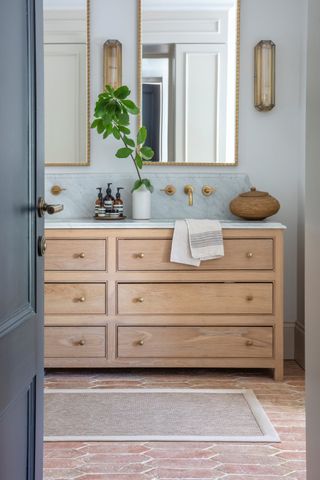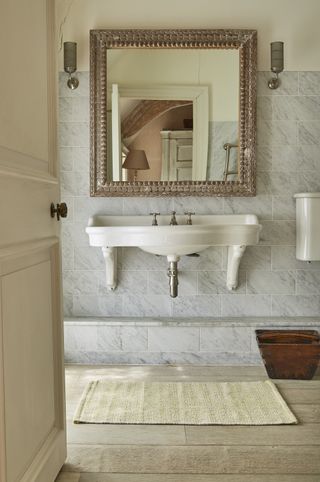Is carpet in a bathroom always a bad idea?
We weigh the pros and cons of using carpet in a bathroom, covering everything from cleanliness and ease of maintenance to style and practicality

Carpet in a bathroom is one of those polarising topics that can divide bathroom designers. On one hand, the comfort of a fluffy carpet is undeniably more appealing than stepping onto a cold tiled floor. On the other hand, the idea of a bathroom floor that can't be wiped clean raises concerns for many.
For most homeowners, carpeting a bathroom feels like an outdated bathroom design trend best left in the 1970s and '80s. But with retro décor experiencing a resurgence – and even avocado bath suites making a comeback – could it be time to reassess our relationship with carpeted bathrooms?
Below, we’ll weigh the pros and cons of using carpet in a bathroom, covering everything from cleanliness and ease of maintenance to style and practicality.
Is carpet in a bathroom always a bad idea?
Before we examine the pros and cons of carpet in a bathroom, it's important to consider why tiled bathroom floors and vinyl flooring are often considered to be better suited to these spaces.
'It’s vital that bathroom flooring can withstand spills, splashes, and high traffic, for both practicality and overall aesthetics,' explains Lorna Williams, Head of Product Design and Visual Creation at Amtico. 'Natural wood or stone alternatives such as luxury vinyl tiling (LVT) are a practical yet stylish choice for a bathroom space that will be water and slip resistant, scratch and stain resistant, and warmer to walk on barefoot.'

Lorna heads up the design studio at Amtico Flooring and leads the design and development of new products. She is also responsible for the creation, maintenance and evolution of Amtico International’s brands, including digital developments.
Floor tiles and vinyl floors are also easy to clean and maintain, making them ideal for high-moisture environments. Unlike carpets, which tend to absorb moisture, these hard floors are better suited to dealing with the inevitable spills and splashes that come with everyday bathroom use.
What’s more, you can buy bathroom floor tiles and buy vinyl flooring in a vast array of colours, patterns, and textures, so you’re guaranteed to find something that will suit your bathroom aesthetic.
So how does carpet compare to these tried-and-tested materials?
The pros of carpet in a bathroom

Whether or not you choose to carpet a bathroom is ultimately a matter of personal preference, but there are some benefits to opting for this type of flooring.
Non-Slip Surfaces
'A carpet made specifically for the bathroom can greatly reduce the risk of post-bath falls from wet and slippery floors,' explains Jodie Hatton, design manager at Brintons. This is especially important for households with young children and elderly individuals who are more prone to slips and accidents.
'When selecting the right type of carpet look for loop pile carpets,' adds Jodie. 'These styles ensure that the pile remains low and flat. Lower pile carpeting also dries faster, whereas thick piling traps moisture and is difficult to dry out.'

Jodie is a textile designer with over 10 years of experience in bespoke design, focusing on high-end interior projects. She is the Design Manager at Brintons, purveyors of designer carpets, and she is currently working towards completing a master's in design research, focusing on sustainable and regenerative design solutions.
Style
If you're drawn to colourful bathroom flooring ideas it's incredibly easy to find the perfect shade of carpet to suit your design scheme. With an extensive selection of colours, textures, and patterns available to purchase online, carpet allows you to stray away from the usual brown and grey tones of hardwood floors or natural stone.
Similarly, if you prefer the look of a traditional bathroom, the soft, textured surface of carpet can add warmth and depth to a room, especially in a small bathroom where hard surfaces can feel cold and uninviting.
Comfort and Warmth
Stepping out onto a soft, warm carpet after a bath or shower is undeniably luxurious, and its cushioned surface provides a level of comfort that hard flooring cannot match. This can be particularly beneficial for individuals with joint pain or limited mobility, as the soft surface can reduce strain on joints and provide a more secure footing.
However, it's worth remembering that a similar level of comfort can also be achieved using large bath mats and washable area rugs.
The cons of carpet in a bathroom

Of course, there's a reason most bathroom designers have avoided carpets in recent years. Here are a few downsides to consider before installing carpet in a bathroom.
Hygiene
'Carpeting a bathroom isn’t advisable due to hygiene reasons as well as high moisture levels,' warns Kirsty Barton, brand storytelling manager for Alternative Flooring. 'Using carpet in these spaces can lead to mould or mildew buildup.'
Bathrooms are inherently humid environments, with showers, baths, and sinks constantly introducing moisture into the air. Without sufficient bathroom ventilation, a high tog carpet is likely to absorb most of this excess moisture, which can create a breeding ground for bacteria, mould, and mildew. Not only can this damage the carpet fibers, but it also poses a potential health risk, particularly for individuals with allergies or respiratory sensitivities.

Kirsty has been working at Alternative Flooring for over 20 years. She has been instrumental in shaping Alternative Flooring's brand identity and is committed to the company's core pillars: people, product, and planet.
Maintenance
It's difficult enough to keep a carpet clean in a living room or a bedroom, let alone in a bathroom. All carpets require regular vacuuming to remove dust, hair, and other debris, but this surface-level cleaning may not be sufficient in a bathroom setting, where water stains and bathroom-related odours can wreak havoc on these surfaces.
Deep cleaning a carpet, either professionally or with specialist cleaning products, can also be time-consuming and costly. These ongoing maintenance demands are a significant drawback when carpeting a bathroom, especially in high-traffic spaces where the carpet will be subjected to frequent use and spills.
Water Damage
Most carpet fibres are not designed to withstand prolonged exposure to water. Repeated soaking and drying can cause the fibres to break down, leading to discoloration, matting, and even structural damage to the carpet and underlying floor. For this reason, many of the carpet manufacturers we contacted were not able to comment on the suitability of ordinary carpets in a bathroom setting, which raises a red flag for this type of flooring.
What is the best type of carpet for bathrooms?
If you are still determined to use carpet in a bathroom, despite the obvious downsides, make sure you choose a style of carpet specifically designed for these spaces. Look for carpets made from synthetic fibres like nylon or olefin, as these are more resistant to moisture and stains than natural carpets. It's also advisable to opt for a low-pile carpet with a tight weave, as this will make it easier to clean and less likely to trap dirt and moisture. When in doubt, opt for easy-to-clean and water-resistant ranges, and be mindful that none of these are designed for use in splash zones or areas with very high moisture levels.
The best alternative bathroom floors
Some good alternatives to carpet in a bathroom include materials like cushioned vinyl or cork flooring. Both options can offer a softer, warmer feel than traditional tiles while still providing the durability and moisture resistance required in a humid bathroom environment.
'Rather than carpet, you could also look for bathroom rugs made from synthetic materials that are designed to withstand moisture,' adds Kirsty Barton from Alternative Flooring. 'These bathroom accessories are the ideal solution for those looking for a softer option underfoot.'
If warmth and comfort are your main priorities, you may also want to consider installing underfloor heating. These systems can provide consistent and gentle warmth throughout a bathroom floor, allowing you to create a luxurious and comfortable feel underfoot without the need for carpet. These systems can be combined with various materials, with the best flooring for underfloor heating being tile and stone.
While bathroom carpets can offer warmth and comfort, there are a range of hygiene and maintenance concerns that make them an impractical choice. Most bathroom designers tend to agree that the best solution is to compromise with a combination of easy-to-clean hard flooring and a plush, regularly laundered bath mat.
Get the Homebuilding & Renovating Newsletter
Bring your dream home to life with expert advice, how to guides and design inspiration. Sign up for our newsletter and get two free tickets to a Homebuilding & Renovating Show near you.

Gabriella is an interiors journalist and has a wealth of experience creating interiors and renovation content. She was Homebuilding & Renovating's former Assistant Editor as well as the former Head of Solved at sister brand Homes & Gardens, where she wrote and edited content addressing key renovation, DIY and interior questions.
She’s spent the past decade crafting copy for interiors publications, award-winning architects, and leading UK homeware brands. She also served as the Content Manager for the ethical homeware brand Nkuku.
Gabriella is a DIY enthusiast and a lover of all things interior design. She has a particular passion for historic buildings and listed properties, and she is currently in the process of renovating a Grade II-listed Victorian coach house in the West Country.